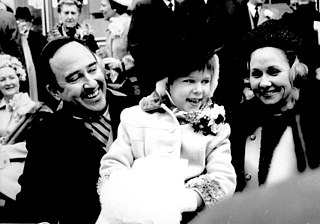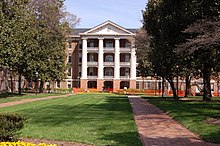
North Carolina is a state in the Southeastern region of the United States. It is bordered by Virginia to the north, the Atlantic Ocean to the east, South Carolina to the south, Georgia to the southwest, and Tennessee to the west. The state is the 28th-largest and 9th-most populous of the United States. Along with South Carolina, it makes up the Carolinas region of the East Coast. At the 2020 census, the state had a population of 10,439,388. Raleigh is the state's capital and Charlotte is its most populous city. The Charlotte metropolitan area, with an estimated population of 2,805,115 in 2023, is the most populous metropolitan area in North Carolina, the 22nd-most populous in the United States, and the largest banking center in the nation after New York City. The Research Triangle, with an estimated population of 2,368,947 in 2023, is the second-most populous combined metropolitan area in the state, 31st-most populous in the United States, and is home to the largest research park in the United States, Research Triangle Park.

Raleigh is the capital city of the U.S. state of North Carolina and the seat of Wake County. It is the second-most populous city in North Carolina, after Charlotte. Raleigh is the tenth-most populous city in the Southeast, the 41st-most populous city in the U.S., and the largest city of the Research Triangle metro area. Raleigh is known as the "City of Oaks" for its many oak trees, which line the streets in the heart of the city. The city covers a land area of 148.54 square miles (384.7 km2). The U.S. Census Bureau counted the city's population as 467,665 at the 2020 census. It is one of the fastest-growing cities in the United States. The city of Raleigh is named after Sir Walter Raleigh, who established the now-lost Roanoke Colony in present-day Dare County.

North Carolina State University is a public land-grant research university in Raleigh, North Carolina, United States. Founded in 1887 and part of the University of North Carolina system, it is the largest university in the Carolinas. The university forms one of the corners of the Research Triangle together with Duke University in Durham and the University of North Carolina at Chapel Hill. It is classified among "R1: Doctoral Universities – Very high research activity".

The University of North Carolina at Chapel Hill is a public research university in Chapel Hill, North Carolina. Chartered in 1789, the university first began enrolling students in 1795, making it one of the oldest public universities in the United States.

Wake County is located in the U.S. state of North Carolina. As of the 2020 census, its population was 1,129,410, making it North Carolina's most populous county. From July 2005 to July 2006, Wake County was the 9th-fastest growing county in the United States, with Cary and Raleigh being the 8th- and 15th-fastest growing communities, respectively.

Guilford County is a county located in the U.S. state of North Carolina. As of the 2020 census, the population was 541,299, making it the third-most populous county in North Carolina. The county seat and largest community is Greensboro. Since 1938, an additional county court has been located in High Point. The county was formed in 1771. Guilford County is included in the Greensboro-High Point, NC Metropolitan Statistical Area, which is also included in the Greensboro–Winston-Salem–High Point, NC Combined Statistical Area.

Mebane is a city located mostly in Alamance County, North Carolina, United States, and partly in Orange County. The town was named for Alexander Mebane, an American Revolutionary War general and member of the U.S. Congress. It was incorporated as "Mebanesville" in 1881, and in 1883 the name was changed to "Mebane". It was incorporated as a city in 1987. The population as of the 2020 census was 17,768. Mebane is one of the fastest-growing municipalities in North Carolina. Mebane straddles the Research Triangle and Piedmont Triad Regions of North Carolina. The bulk of the city is in Alamance County, which comprises the Burlington Metropolitan Statistical Area, itself a component of the Greensboro-Winston-Salem-High Point Combined Statistical Area. Two slivers in the eastern portion of the city are in Orange County, which is part of the Durham-Chapel Hill Metropolitan Statistical Area, itself a component of the Raleigh-Durham-Chapel Hill Combined Statistical Area.

The USA South Athletic Conference is an athletic conference which competes in the NCAA's Division III. Member schools are located in North Carolina and Virginia.

The Governor's School of North Carolina is a publicly funded residential summer program for intellectually gifted high school students in the state of North Carolina. North Carolina's Governor's School was the first such program in the United States, and has given rise to similar programs for gifted students in many other states.

The Research Triangle, or simply The Triangle, are both common nicknames for a metropolitan area in the Piedmont region of the U.S. state of North Carolina. Anchored by the cities of Raleigh and Durham and the town of Chapel Hill, the region is home to three major research universities: North Carolina State University, Duke University, and the University of North Carolina at Chapel Hill, respectively. The "Triangle" name originated in the 1950s with the creation of Research Triangle Park located between the three anchor cities, which is the largest research park in the United States and home to numerous high tech companies.

Woody Lombardi Durham was an American play-by-play radio announcer for the North Carolina Tar Heels football and men's basketball programs from 1971 to 2011.

On March 3, 2006, Mohammed Reza Taheri-azar intentionally hit people with a sport utility vehicle on the campus of the University of North Carolina (UNC) at Chapel Hill to "avenge the deaths of Muslims worldwide" and to "punish" the United States government. While no one was killed in the vehicle-ramming attack, nine people were injured.

Peace College Main Building is the focal point of the Peace College campus in Raleigh, North Carolina. Built between 1859 and 1862, Main Building is located at the northern end of Wilmington Street in downtown Raleigh and is considered one of the largest antebellum buildings surviving in the city. During its early history, Main Building was used as a military hospital and offices for the Freedmen's Bureau. The building now contains offices, parlors, banquet rooms, and dormitory residences. Main Building was listed on the National Register of Historic Places in 1973 and is a designated Raleigh Historic Landmark.

Jessie Rae Scott was an American politician who served as the First Lady of North Carolina from 1969 to 1973 through her marriage to North Carolina Governor Robert W. Scott.
Thales Academy is a network of private non-sectarian community schools located primarily in central North Carolina. The school was founded in 2007 by Robert L. Luddy and graduated its first senior class in 2016 with three seniors. As of 2021, there are over 3600+ students stretched across 12 campuses mainly based in North Carolina, but also a campus located in Virginia and Tennessee. The Pre-K–12 college preparatory school was named for the Greek philosopher Thales of Miletus, often credited as the father of Greek Philosophy.
The history of North Carolina Agricultural and Technical State University, the first land grant college for people of color in the state of North Carolina, can be traced back to 1890, when the United States Congress enacted the Second Morrill Act which mandated that states provide separate colleges for the colored race. The "Agricultural and Mechanical College for the Colored Race" was established On March 9, 1891 by an act of the General Assembly of North Carolina and began in Raleigh, North Carolina as an annex to Shaw University. The college made a permanent home in Greensboro with the help of monetary and land donation by local citizens. The college granted admission to both men and women from 1893 to 1901, when the board of trustees voted to restrict admission to males only. This policy would remain until 1928, when female students were once again allowed to be admitted.

Lily Connally Morehead Mebane was an American relief worker, politician, and heiress. During World War I, she chaired the Rockingham County Committee of the North Carolina Division of the Woman's Committee of the Council of National Defense. She worked in France and Romania with the American Committee for Devastated France, where she met Queen Marie of Romania. She remained friends with the Queen Marie until the queen's death in 1938. For her relief work during the war, Mebane was awarded the Cross of Mercy by King Peter I of Serbia and was made Knight of the Legion of Honour by the French government.

Jane Simpson McKimmon was an American author and agricultural educator, civic leader, state home demonstration agent, and director of women's institutes.

Sherwood Battle Brockwell was a fire marshal, pioneer of fire safety and legislation in North Carolina, and Raleigh's first paid fire chief. Brockwell was the United States' oldest fire marshal at the time of his death.




















